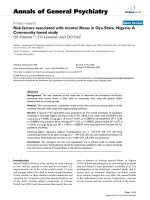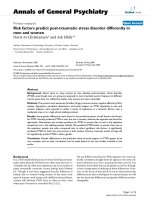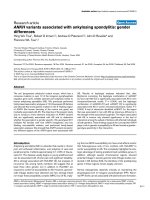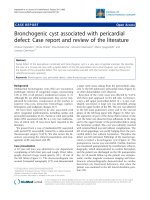Báo cáo y học: "Risk factors associated with mental illness in Oyo State, Nigeria: A Community based study" pps
Bạn đang xem bản rút gọn của tài liệu. Xem và tải ngay bản đầy đủ của tài liệu tại đây (211.86 KB, 6 trang )
BioMed Central
Page 1 of 6
(page number not for citation purposes)
Annals of General Psychiatry
Open Access
Primary research
Risk factors associated with mental illness in Oyo State, Nigeria: A
Community based study
OE Amoran*
1
, TO Lawoyin
1
and OO Oni
2
Address:
1
Department of Community Medicine, University College Hospital, Ibadan, Nigeria and
2
Office of Medical officer of Health, Saki East
Local Govt Area, Oyo State, Nigeria
Email: OE Amoran* - ; TO Lawoyin - ; OO Oni -
* Corresponding author
Abstract
Background: The main objective of this study was to determine the prevalence and factors
associated with mental illness in Oyo State at community level using the general health
questionnaire as a screening tool.
Method: This cross-sectional, community- based survey was carried out among adults in three
randomly selected LGAs using multi-stage sampling technique.
Results: A total of 1105 respondents were assessed in all. The overall prevalence of psychiatric
morbidity in Oyo state Nigeria was found to be 21.9%, (18.4% in the urban areas and 28.4% in the
rural areas, p = 0.005). Young age ≤ 19 yrs (X
2
= 20.41, p = 0.00013), Unemployment (X
2
= 11.86
p = 0.0005), living condition below average (X
2
= 12.21, p = 0.00047), physical health (X
2
= 6.07, p
= 0.014), and large family size (X
2
= 14.09 p = 0.00017) were associated with increase risk for
psychiatric morbidity.
Following logistic regression analysis, Unemployment (C.I = 1.18–3.70, OR -2.1) and living
conditions perceived to be above average (C.I = 1.99–5.50, OR-3.3) were significant predictors of
mental illness while family size less than 6 (C.I = 0.86–0.97, OR-0.91) was protective.
Conclusion: The teenagers and the rural populations are in greater need of mental health
promotional services. Family planning should be made freely available in order to reduce the family
size and hence incidence of mental illness in the African population.
Introduction
Mental health is defined as the capacity to work, capacity
to love and the capacity to play and for recreation [1].
Approximately one in five of the world's youth, 15 years
and younger suffer from mild to severe mental disorders.
A large number of these children remain undetected and
untreated [2]. It must be noted that mental health is one
of the more recently added components of Primary
Health Care (PHC) and means more than merely the pres-
ence or absence of obvious mental illness. In Nigeria
28.5% of those attending primary care setting in an urban
area were found to have psychiatric morbidity [3,4]. The
disintegration of the traditional, extended family due to
factors such as economic migration inevitably creates
socio-cultural changes that may affect the mental health
of the individuals in the society. Furthermore, concerns
for job security and the economic survival of the house-
Published: 22 December 2005
Annals of General Psychiatry 2005, 4:19 doi:10.1186/1744-859X-4-19
Received: 31 May 2005
Accepted: 22 December 2005
This article is available from: />© 2005 Amoran et al; licensee BioMed Central Ltd.
This is an Open Access article distributed under the terms of the Creative Commons Attribution License ( />),
which permits unrestricted use, distribution, and reproduction in any medium, provided the original work is properly cited.
Annals of General Psychiatry 2005, 4:19 />Page 2 of 6
(page number not for citation purposes)
hold can create enormous pressure on individuals which
may in turn affect their mental health [5,6].
Available studies have been largely facility-based, while
community- based studies have been very scanty. Several
studies have been done using general health question-
naire (GHQ12) as a tool for screening mental illness in
developed countries where the prevalence of psychiatric
morbidity ranges between 17%–25% [6-8]. This study
assessed the prevalence of and factors associated with
mental illness in Oyo State at community level using the
general health questionnaire as a screening tool. The pub-
lic health significance of this study is that it will provide a
conceptual framework for addressing mental health pro-
motion goals. It also offers a highly appropriate frame-
work through which community-based mental health
activities could be addressed. Moreover, it could also be
used for health planning and practice.
Materials and methods
The study was carried out in Oyo State one of the 36 states
in Nigeria. This community based study is cross sectional
in design and aimed at collecting data on mental health in
rural and urban Oyo State, Nigeria.
Sampling procedure
Multistage sampling technique was used to obtain a rep-
resentative sample of the communities in Oyo state. The
communities where the study was carried out were chosen
as follows:
Stage 1
A sampling frame of all the local government areas in Oyo
state was drawn and stratified into urban and rural areas
based on World bank classification [9]. One rural and two
urban local government areas was obtained by simple
random sampling (balloting). This is based on the fact
that two thirds of Oyo state is urbanized. Ibadan North-
West, Egbeda and Saki-East local government areas were
selected.
Stage 2
Sampling frame of all the communities in the selected
local government areas was drawn. The communities
where the study was carried out were randomly selected
by simple random sample (balloting). The communities
selected were Idikan in Ibadan North-west LGA, Olu-
badan Estate in Egbeda LGA and Ago-amodu in Saki-East
LGA.
Stage 3
Using the PHC house numbering where available (in
places where it has not been done the houses were num-
bered for the purpose of the study). Systematic sampling
technique was employed to select the houses that were
visited in the chosen communities. Seventy-four houses
were selected in Idikan, eighty-five houses in Olubadan
Estate and ninety-eight houses in Ago-amodu.
Stage 4
One household in each of the houses selected were
recruited into the study.
Stage 5
Every resident aged 15 years and above who has resided in
the area for at least 6 months was interviewed in the
households selected. A total of one thousand, one hun-
dred and five subjects were recruited into the study.
A sample size formulae for comparing two proportions
was used to obtain the sample size. Prevalence of 12.0%
of poor mental health using GHQ 12 questionnaire
among clinical students of University of Ibadan was used
as estimate for urban community, while the prevalence of
21.3% among rural primary health care patients in
Nigeria was used for rural community [4,5]. A precision of
95% is desired with a power of 90%. The calculated sam-
ple size was 610 while this was doubled to 1220 with
response rate of 90.6% (1105 responses).
Data collection
The study was conducted using an interviewer adminis-
tered structured questionnaire. The GHQ-12 was used to
assess mental health status of the respondents. Scores
were calculated with a 0-1-1 scale with a maximum score
of 1 and a minimum score of 0 for each item. A score of
three or more was used as cut-off to classify into good and
poor mental health. WHO quality of life questionnaire is
a five point scale with items which ranged in rating from
"very poor", "not at all" or "very dissatisfied" (1 point) to
"very good", "extreme amount" or "very satisfied" (5
points). For items with reverse scores "not at all" was
scored 5 and "extreme amount" was scored 1. The score
for both mentally healthy and mentally ill was computed
to asses the effect of psychiatric morbidity on quality of
life.
This questionnaire was translated into the local language
for easy administration and translated back to English to
ensure accuracy of translation. The GHQ (12) and WHO
quality of life questionnaires were administered by
research assistants after adequate training and the author's
supervision. Research assistants were recruited from the
communities and were trained to administer the ques-
tionnaires. The research assistants were recruited based on
minimum qualification of OND certificate. They were
trained on how to extract the information on psychiatric
symptoms and their relevance to the research work. They
were also guided through a good number of question-
Annals of General Psychiatry 2005, 4:19 />Page 3 of 6
(page number not for citation purposes)
naires until a reasonable level of competence had been
attained before being left to do it themselves.
Data generated in the study were manually cleaned and
then entered into the Computer using SPSS 10 statistical
software for analysis. Logistic regression analysis was
done to determine factors associated with mental ill
health in rural and urban Oyo State and also to remove
the effect of confounding variables. The dependent varia-
ble was psychiatric morbidity as a dichotomous variable
with a score of less than 3 being an option indicating good
mental health while a score of 3 and more being another
option indicating abnormal or psychiatric morbidity. All
the variables which were significant in the bivariable anal-
Table 1: Socio-demographic characteristics and Mental Health Status
Characteristics Total No & (%) Psychiatric Morbidity No & (%)
Age
15–19 197 (17.8) 86 (43.7)
20–39 529 (47.3) 92 (17.4)
40–64 304 (28.0) 51 (16.8)
>65 75 (6.9) 13 (17.3)
1105 (100.0) 242 (21.9)
Sex
Male 415 (37.6) 75 (18.1)
Female 690 (62.4) 1105 (100.0) 167 (24.2) 242 (21.9)
Tribe
Indigenes 1045 (94.6) 222 (21.2)
Non- Indigenes 60 (5.4) 20 (33.3)
1105 (100.0) 242 (21.9)
Location
Urban 721 (65.3) 133 (18.4)
Rural 384 (34.7) 109 (28.4)
1105 (100.0) 242 (21.9)
Table 2: Family characteristics and Mental Health Status
Characteristics Total No & (%) Psychiatric Morbidity No & (%)
Marital Status
Single (Never Married) 447 (40.4) 125 (28.0)
Married 564 (51.0) 89 (15.7)
Separated, Divorced or Widowed 94 (8.6) 28 (29.8)
1105 (100.0) 242 (21.9)
Type of family
Nuclear 554 (50.1) 108 (19.5)
Extended 551 (49.9) 114 (20.7)
1105 (100.0) 242 (21.9)
Type of Marriage
Monogamy 542 (49.0) 112 (20.7)
Polygamy 563 (51.0 130 (23.1)
1105 (100.0) 242 (21.9)
Family size
<6 793 (71.8) 126 (15.9)
>6 312 (28.2) 116 (37.2)
1105 (100.0) 242 (21.9)
Annals of General Psychiatry 2005, 4:19 />Page 4 of 6
(page number not for citation purposes)
ysis with a p < 0.08 were fed into the model. Odd ratios
were adjusted and p values of <0.05 were taken as signifi-
cant for the study.
Results
Demographic characteristics
Psychiatric morbidity was more prevalent in the rural
population (28.4%) compared with the urban population
(18.4%) (X
2
= 3.69 p = 0.005). The adolescents in this
study (15–19 yrs) had the highest prevalence of psychiat-
ric morbidity (43.7%, p = 0.00013) in Oyo state. The indi-
genes, that is, the Yorubas were more mentally stable
when compared with the migrant tribes (the Ibos, Hausas
and other minority tribes) (21.2% vs 33.3% p = 0.253).
Females had higher prevalence of psychiatric morbidity
(24.2% vs 18.1%, X
2
= 0.83 p = 0.36).
Family characteristics
The Single (never married & separated and divorced) had
a higher morbidity rate when compared with the married
(p= 0.091). This is shown in table 2. Fewer respondents
living within the extended family structure had higher
prevalence of mental ill-health when compared with
those living within nuclear family structure, (X
2
= 0.09,
1df p = 0.766). Those living within monogamous family
structure had higher prevalence for psychiatry morbidity.
(X
2
= 0.23, p = 0.634). Small sized families were signifi-
cantly mentally healthier than large size families (X
2
=
14.09 p = 0.00017).
Socio- economic characteristics
The unemployed had the highest prevalence for psychiat-
ric morbidity when compared with the employed (X
2
=
11.86 p = 0.00058). Among those employed, the senior
professionals had the highest unadjusted psychiatric mor-
bidity rate (23.2%) while the students had a relatively
high prevalence of mental ill-health (37.3%) when com-
pared with others that are employed. Educational level
was collapsed into two groups (high and low). Respond-
ents with high level of formal education (secondary level
Table 3: Socio-economic characteristics and Mental Health Status
Characteristics Total No & (%) Psychiatric Morbidity No & (%)
Occupation
Senior Professional 95 (8.6) 22 (23.2)
Junior Professional 103 (9.3) 22 (21.4)
Skilled 353 (31.9) 64 (18.1)
Unskilled 400 (36.2) 67 (16.8)
Students 75 (6.2) 28 (37.3)
Unemployed 79 (7.1) 39 (49.4)
1105 (100.0) 242 (21.9)
Job Status
Employed 924 (92.9) 203 (21.9)
Unemployed 79 (7.1) 39 (49.4)
1105 (100.0) 242 (21.9)
Education
Low 475 (43.0) 90 (18.9)
High 530 (57.0 152 (24.1)
1105 (100.0) 242 (21.9)
Physical health
Poor 538 (48.7) 155 (28.8)
Good 567 (51.3) 87 (15.3)
1105 (100.0) 242 (21.9)
Social health
Poor 599 (54.2 183 (30.5)
Good 506 (45.8) 59 (11.7)
1105 (100.0) 242 (21.9)
Living condition
Below average 570 (51.6) 195 (34.2)
Above average 535 (48.4) 47 (8.8)
1105 (100.0) 242 (21.9)
Annals of General Psychiatry 2005, 4:19 />Page 5 of 6
(page number not for citation purposes)
and above) had a higher morbidity rate than those with
low level of formal education (Nil and primary) (X
2
=
0.97, p = 0.325).
The respondents who perceived their living condition to
be above the average for their status were more mentally
stable compared with those who did not (X
2
= 8.13 p =
0.0043). Those with chronic mental illness had a higher
prevalence of psychiatric morbidity (X
2
= 6.07 p = 0.014).
Furthermore, those with good social relationship were
more mentally stable (X
2
= 8.13 p = 0.0043).
Multivariate logistic analysis
Table 4 shows the adjusted odds ratio and the confidence
interval for the risk of mental illness in Oyo State. Family
size greater than 6 (p = 0.002), reported living conditions
above average (p = 0.0001) and unemployment (p =
0.011) increased the risk of mental ill health. The presence
of physical illness (p = 0.056) was of borderline signifi-
cance for mental illness.
Discussion
This study examined the prevalence of psychiatric mor-
bidity in the urban and rural areas of Oyo state with a view
to identify the factors that are associated with mental ill-
ness in the general population at the community level.
The overall prevalence of psychiatric morbidity found at
the community level in this study was 21.9%. It is how-
ever slightly higher than what is found in other commu-
nity-based surveys carried out in developed countries such
as Spain, Canada, Norway and Australia [9-11].
The prevalence of psychiatric morbidity in the rural area
was found to be significantly higher than the prevalence
in the urban location. This is contrary to what was found
in similar studies carried out in developed countries such
as Great Britain where mental disorder was commoner in
the urban areas than in the rural population [12]. The
adolescent age group was found to have higher psychiatric
morbidity when compared to the adults. Similar observa-
tions have been made in several studies [21,22]. The ado-
Table 4: Adjusted Odds Ratio for the Risk of Mental Illness in Oyo State
Variables Odd Ratio Confidence Interval P-value
Marital status 1.34 0.84–2.10 0.22
Not Married 1.00
Married
Family size 0.91 0.86–0.97 <0.0005
<6 1.00
>6
Age 0.72 0.18–2.90 0.66
15–19 1.58 0.80–3.10 0.19
20–39 1.24 0.78–1.90 0.36
40–64 1.00
>64
Location 0.53 0.22–1.28 0.158
Urban 1.00
Rural
Living Condition
Below average 3.30 1.99–5.50 0.001
Above average 1.00
Socio-economic class
unemployed 2.10 1.18–3.70 0.01
Low 1.40 0.91–2.15 0.12
High 1.00
Social Health 1.32 0.77–2.27 0.31
Below average 1.00
Above average
Physical Health 1.58 0.99–2.52 0.06
Below average 1.00
Above average
Annals of General Psychiatry 2005, 4:19 />Page 6 of 6
(page number not for citation purposes)
lescent period is a turbulent period in life when there is
transition into adulthood and self autonomy. This may
explain the higher morbidity rates [23].
The study underlines the effect of family structure on the
mental health of the population. Marriage was found to
be associated with mental stability in Oyo state. Those
separated from their spouses, divorcees and widows had a
higher mental morbidity. Sticking to acceptable family
structures may create mental tension in the communities
studied. Aspiration to meet up to the community stand-
ards is usually a common source of mental stress. [14,15].
The indigenes were found to be more mentally stable than
non-indigenes showing that migrants in Nigeria may be
predisposed to setbacks psychologically when compared
with the indigenes. This needs however to be further
investigated as this is contrary to research done among
Canadian Chinese migrants which shows that they do not
suffer mentally compared with the general Chinese popu-
lation [15].
Large family size and Unemployment was found to be
associated with increase in psychiatric morbidity. This
study corroborates the findings of several authors who
found out that the larger the size of the family the lower
the quality of child upbringing. This may lead to delin-
quent behavior among the children and increased mental
stress on the care providers [16,17]. Unemployment is an
important risk factor for mental illness and a significant
determinant in the development of mental pathology
especially among the adolescents [18]. However among
those with employment the professionals had the highest
morbidity rate. The possible reason for this in a Nigerian
population is not immediately clear. Those with high
level of formal education had higher psychiatric morbid-
ity rate in the Nigerian community. This is similar to the
conclusion of many authors [19,20].
This study shows that prevalence of psychiatric morbidity
is high in Oyo state, Nigeria and slightly higher than what
is obtained in the community- based studies in the devel-
oped countries. The rural population is in greater need of
mental health promotional services. Basic essential needs
provided by the government in both rural and urban areas
especially made available to the younger generation and
promotion of family planning to reduce family size would
help to reduce psychiatric morbidity and improve quality
of life in this African population.
References
1. World Health Organization: Mental Health Division. Technical
report 1993:1.
2. World Health Organization: Mental health division. Publication on
World health day. Mental health around the World 2001:3.
3. World Health Organization: Quality of life assessment. World
Health Chronicle 1976, 30(8):312.
4. Ohaeri JU, Odejide OA, Gureje O, Olatawura MO: The prevalence
of psychiatric morbidity among adult attenders in the five
PHC facilities of a rural community in Nigeria psychopathol-
ogy africaine. 1994, 26(1):97-108.
5. Omokhodion FO, Gureje O: Psychological problems of clinical
students in the University of Ibadan Medical School. Afr J Med
Sci 2003, 32:55-58.
6. Odejide AO, Oyewunmi LK, Ohaeri JU: Psychiatry in Africa; An
overview. Am J Psychiatric 1989, 146(6):708-716.
7. Goldberg D, Huskey P: common mental disorders. A Bio social
model Routledge/tavistock publ London 1992.
8. Satoriuos N, Ushin Costa TB, Silva E, Goldberg D, Lecrubier Y,
Ormel H, VonKorff M, Uwittchen : An International study of psy-
chological problems in Primary care preliminary report
from the WHO collaborative project on psychological prob-
lems in General health care Arch Gen Psychiat. 1993,
50:819-824.
9. World Bank Study: Classification of Oyo State into rural and
urban settlement. 1998.
10. Rajimil L, Gispert MR, Roset GM, Munoz RE, Segura BA: Prevalence
of mental disorders in the general population of Catalonia.
Team of the Health Survey of Catalonia. Gaceta Sanitaria 1998,
12(4):153-9.
11. Henderson S, Andrew G, Hall W: Australia's mental health: an
overview of the general population survey. Volume 34. Issue 2
Australian & New Zealand Journal of Psychiatry.; 2000:197-205.
12. Sandanger I, Nygard JF, Ingebrigsten G, Sorensen T, Dalgard O: Prev-
alence, incidence and age at onset of psychiatric disorders in
Norway. Social Psychiatry & Psychiatric Epidemiology 1999,
34(11):570-9.
13. Paykel ES, Abbot R, Jenkins R, Brugha TS, Melzer H: Urban-rural
mental health differences in Great Britain; findings from
Nationals morbidity survey. Psychological Medicine 2000,
30(2):269-80.
14. Makanjuola ROA: Recurrent unipolar manic disorder in the
Yoruba Nigeria, further evidence. Br J Psychiat 1985:434-437.
15. Gureje O, Obikoya BO, Ikueesan BA: Prevalence of specific dis-
orders in an urban primary health care. E Afr Med J 1992,
69:282-287.
16. Lai DW: Measuring depression in Canada's elderly Chinese
population: use of a community screening instrument. Cana-
dian Journal of Psychiatry – Revue Canadienne de Psychiatrie 2000,
45(3):279-84.
17. Ebirahim GJ: Street children: a pediatric concern of growing
proportions. J Trop Ped 1984, 30:130-1.
18. UNICEF: The State of the World's children 1997 Oxford University
Press, New York; 1997.
19. Mean Patterson LJ: Long-term unemployment amongst adoles-
cents: A longitudinal study. Journal of Adolescence 1997,
20(3):261-80.
20. Roberts R, Golding J, Towell T, Weinreb I: The effect of economic
circumstances on British students' mental and physical
health. J American college health 1999, 48(3):103-9.
21. Eaton WW, Anthony JC, Madel W, Garrison R: Occupations and
the prevalence of major depressive disorders. J Occup Med
1990, 32(11):.
22. Cosgrave E, McGorry P, Allen N, Jackson H: Depression in young
people. A growing challenge for primary care. Australian Family
Physician 2000, 29(2):123-7.
23. McKelvey R, Davies J, Pfaff J, Acres J, Edwards S: Psychological dis-
tress and suicidal ideation among 15 – 24-year-olds present-
ing to general practice: a pilot study. Australian & New Zealand
Journal of Psychiatry 1998, 32(3):344-8.
24. Solomon DA, Keitner GI, Miller IW, Shea MT, Keller M: Course of
illness and maintainance treatments for patients with bipo-
lar disorder. J Clin Psychiatry 1995, 56:5.








